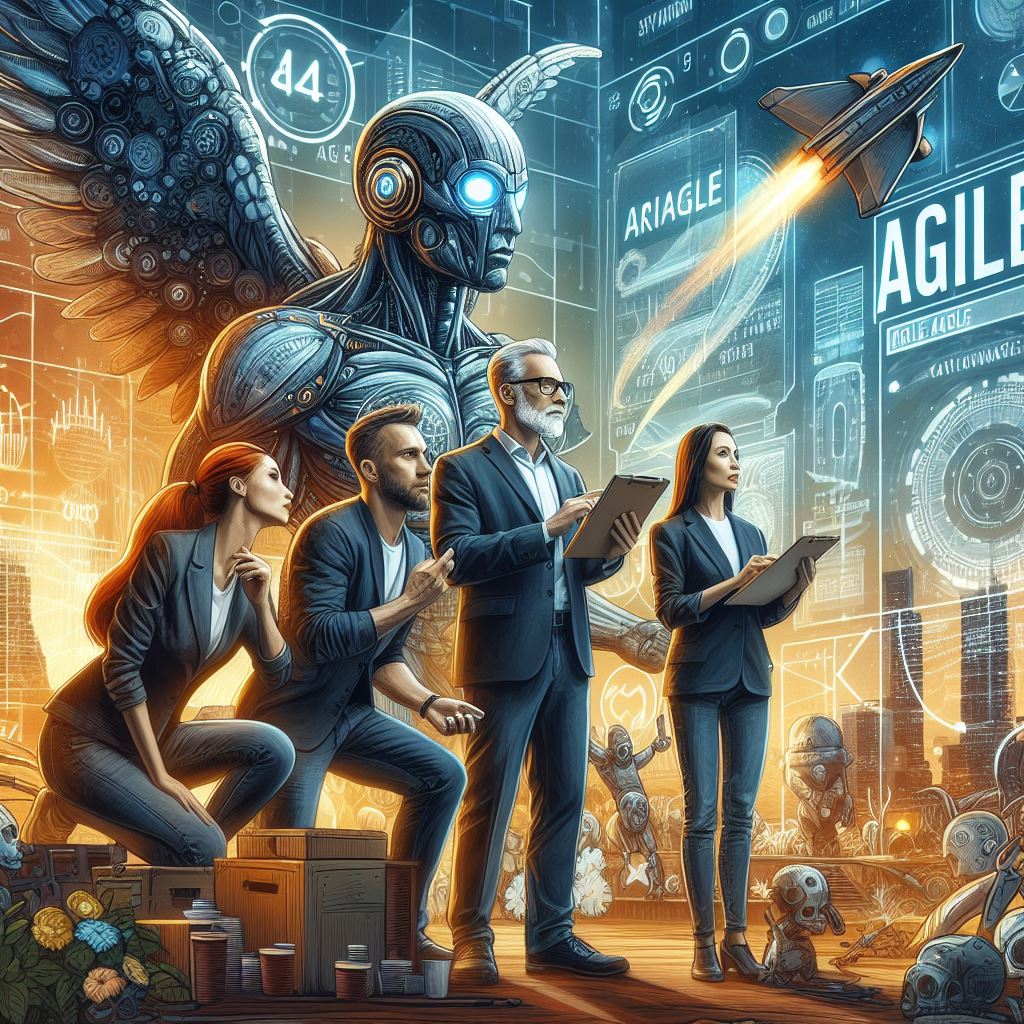Agile Methodologies for AI Project Success
The adoption of Agile methodologies has become increasingly irreplaceable for managing projects effectively. Agile practices, originally designed for software development, are particularly well-suited to the dynamic and sometimes unpredictable nature of AI projects. By emphasizing flexibility, continuous improvement, and collaboration, Agile methodologies help teams adapt to changing requirements, optimize processes, and enhance productivity.
Recent statistics underscore the growing importance of Agile in AI project management. In the 2023 PMI Annual Global Survey on Project Management, 21% of respondents report always or often using AI in project management, 82% of senior leaders foresee AI impacting project management within five years, and a PMI Customer Experience survey finds 91% believe AI will moderately impact the profession, with 58% anticipating a major or transformative effect.
These findings highlight the transformative impact of Agile methodologies on AI project management, enabling teams to navigate the complexities of AI development more effectively and deliver results that align with business goals. As AI continues to permeate various sectors, the integration of Agile practices is not just beneficial but essential for staying competitive and responsive in a technology-driven market.
The Basics of Agile Methodology
Agile methodology is grounded in a set of principles that prioritize flexibility, iterative progress, collaboration, and customer feedback. The core principles, as outlined in the Agile Manifesto, include:
- Individuals and interactions over processes and tools: Valuing human communication and collaboration as the key to successful outcomes.
- Working software over comprehensive documentation: Prioritizing functional prototypes and products over detailed documentation.
- Customer collaboration over contract negotiation: Engaging with customers continuously to accommodate changes and ensure the product meets their needs.
- Responding to change over following a plan: Being open and responsive to changes, even late in development, to better meet project goals.
How Agile Differs in the Context of AI Projects
Applying Agile to AI projects introduces unique challenges and modifications to these principles:
-
Experimentation and Learning
AI projects often involve significant amounts of experimentation and learning to refine algorithms and models. Agile’s iterative nature allows for continuous refinement and adaptation, which is important for handling the uncertainties inherent in AI development.
-
Data-Centric Processes
Unlike traditional software development, AI projects are highly dependent on data quality, availability, and alignment with specific use cases. Agile methodologies in AI stress the importance of iterative data gathering and validation as a core component of the development cycles.
-
Cross-functional Collaboration
AI projects require close collaboration between data scientists, AI engineers, software developers, and domain experts. Agile facilitates this interdisciplinary interaction, ensuring that all perspectives are integrated into the development process.
-
Flexibility in Planning
Due to the exploratory nature of AI, plans may require more frequent adjustments compared to typical software projects. Agile’s flexibility allows teams to pivot quickly based on findings from ongoing testing and feedback loops.
Planning Your AI Project with Agile
When planning an AI project using Agile methodologies, you must set realistic milestones that reflect the iterative nature of AI development. Unlike traditional projects where deliverables may be defined from the start, AI projects benefit from setting milestones that allow for discovery and refinement. Here are some tips for setting these milestones:
-
Start with a Prototype
Early in the project, focus on developing a minimal viable product (MVP) or prototype that incorporates core AI functionalities. This approach allows you to test assumptions and gather feedback quickly.
-
Iterative Enhancements
Set milestones for iterative improvements based on feedback from initial testing phases. This includes enhancing algorithms, expanding data sets, or refining user interfaces.
-
Performance Benchmarks
Include specific performance benchmarks as milestones, such as accuracy rates for machine learning models or response times for AI applications. These benchmarks help gauge progress and direct future development efforts.
-
Scalability Assessments
Plan for milestones that assess the scalability of the AI solution, ensuring it can handle increased loads or expanded use cases as it progresses.
Importance of Flexibility in Planning AI Projects
Flexibility is a cornerstone of Agile methodology and is especially important in AI project planning due to the inherent uncertainties and rapid advancements in AI technology. Here’s why flexibility is vital:
- Adapting to New Insights: As AI projects progress, new insights from data or changes in technology can significantly alter project direction. Agile planning must accommodate these shifts to leverage new opportunities or mitigate emerging risks.
- Evolving Requirements: User requirements can evolve as stakeholders interact with AI functionalities and understand their potential impacts better. Agile allows for continuous refinement of requirements based on real-world use and feedback.
- Technological Shifts: AI technology is subject to rapid changes, including new frameworks, tools, or algorithms. Flexible planning ensures that projects can incorporate these advancements without extensive rework.
By integrating flexibility into the planning process, AI projects managed with Agile methodologies can remain adaptive and responsive, ensuring they meet user needs and stay at the forefront of technological innovation. This approach not only improves the success rate of AI projects but also fosters a culture of continuous learning and improvement.
Sprints and Iterations in AI Development
Sprints, a key component of Agile methodology, are short, time-boxed periods during which specific work must be completed and made ready for review. Adapting sprints to AI development involves several strategic modifications to accommodate the unique challenges and requirements of AI projects:
-
Variable Sprint Lengths
While traditional Agile sprints might last a fixed duration (e.g., two weeks), AI projects may benefit from variable sprint lengths based on the complexity of tasks, such as data preprocessing, feature engineering, or model training.
-
Focused Objectives
Each sprint in an AI project should have a clear, focused objective that aligns with the overall project goals, whether it’s improving model accuracy, integrating new data sources, or implementing a new algorithm.
-
Review and Retrospective
At the end of each sprint, review the completed work. This should include evaluating the AI model’s performance against predefined benchmarks and discussing what can be improved in the next iteration.
Case Studies of Successful Sprint Implementations
Several organizations have successfully implemented Agile sprints in their AI development projects, demonstrating significant benefits:
-
Mitsubishi
This multinational company, active in sectors such as aerospace and power generation, implemented Agile methodologies through comprehensive workshops that introduced Agile practices across various departments. The initiative started at the headquarters in Japan and gradually extended to other factories, fostering a culture that values continuous improvement and rapid response to change (GitScrum Skyrocket Productivity).
-
Accenture
In a collaboration with one of the UK’s leading banks, Accenture applied Agile methodologies to scale up data innovation, identifying over 60 high-value analytics initiatives. This approach involved repeatable use case models and a ‘Value-Discover-Experiment-Prove-Scale’ methodology, emphasizing the agile mindset’s ability to adapt and innovate rapidly in the face of evolving business needs (Accenture | Let There Be Change).
-
IBM
IBM emphasizes the importance of identifying clear business objectives at the outset of an AI project and advocates for an iterative approach to project development. This includes evaluating available data, scoping project requirements, and developing a proof-of-concept before full-scale development. Such a method ensures that AI projects remain aligned with business values and can adapt flexibly to changing circumstances (IBM – United States).
Agile Tools and Techniques for AI
The complexity of AI projects necessitates robust tools that can handle the intricacies of managing data, code, and collaboration. Here are some highly recommended tools for tracking and managing AI projects:
Jira
Widely used for Agile project management, Jira offers powerful features for planning, tracking, and releasing software. Its customizability makes it suitable for managing AI project workflows, tracking issues, and sprints.
Trello
For teams looking for a more visual tool, Trello uses boards, lists, and cards to organize tasks and track progress. It’s excellent for managing smaller AI projects or specific aspects of a larger project, like data collection or model testing.
GitHub
Essential for version control, GitHub allows AI development teams to collaborate on code, manage revisions, and track changes. It also integrates with project management tools like Jira, enhancing workflow synchronization.
Asana
Asana is a project management tool that excels in task allocation and timeline tracking. Its straightforward interface is excellent for managing multi-faceted AI projects and ensuring that all team members are aligned on goals and deadlines.
MLflow
Specifically designed for machine learning projects, MLflow helps manage the machine learning lifecycle, including experimentation, reproducibility, and deployment. It’s particularly useful for tracking different experiments, model versions, and parameters.
Techniques for Maintaining Project Momentum and Focus
Maintaining momentum and focus in AI projects can be challenging due to their complexity and the iterative nature of model development. Here are effective techniques to keep AI projects on track:
- Daily Stand-ups: Implementing daily stand-up meetings helps keep the team aligned on their daily tasks, immediately address any blockers, and quickly adapt to changes. This constant communication is vital for synchronizing the team’s efforts.
- Iteration Reviews: At the end of each sprint, conduct iteration reviews to assess what was accomplished against the sprint goals. This not only highlights progress but also motivates the team by demonstrating tangible outcomes.
- Retrospectives: Regular retrospectives allow the team to reflect on what went well and what didn’t during a sprint. This is essential for continuous improvement, especially in AI projects where learning from each phase of development is key.
- Clear Documentation: Given the technical complexity of AI, maintaining clear and comprehensive documentation is needed. This ensures that everyone on the team, from data scientists to product managers, understands the project’s technical details and progress.
- Buffer Time: Incorporating buffer time in sprints to deal with unexpected challenges or additional research can help maintain momentum. AI projects often encounter unforeseen issues, and having scheduled buffer time prevents these from derailing the project timeline.
By leveraging these tools and techniques, teams can enhance their efficiency and effectiveness in managing AI projects, ensuring that they stay on track and meet their objectives while adapting to the iterative and exploratory nature of AI development.
Overcoming Challenges in Agile AI Projects
Agile AI projects, while flexible and dynamic, are susceptible to certain pitfalls that can derail progress if not carefully managed. Here are some common challenges and strategies to avoid them:
-
Underestimating Data Preparation
AI projects heavily depend on data quality and preparation, which can be time-consuming and complex. To avoid this pitfall, allocate sufficient time and resources for data collection, cleaning, and preprocessing right from the planning phase.
-
Overfitting the Model
There is a tendency to continually tweak AI models to perform well on training data, which can lead to overfitting. Implement cross-validation techniques and keep testing the model on new, unseen data to ensure it generalizes well.
-
Lack of Clear Goals
Without clear, measurable objectives, AI projects can become directionless. Set specific, achievable goals for each sprint and ensure they align with the overall project aims.
-
Silos Between Teams
AI projects often require collaboration between data scientists, engineers, and business stakeholders. Avoid silos by fostering regular communication and integrating tools that enhance collaborative efforts.
Strategies for Dealing with Uncertainty and Complexity in AI
AI projects inherently involve uncertainty and complexity, particularly around data variability and algorithm behavior. Here are strategies to manage these challenges effectively:
-
Incremental Development
Break down the project into smaller, manageable parts and focus on delivering incremental value through sprints. This approach helps in managing complexity by tackling one aspect of the project at a time and adjusting plans as new information becomes available.
-
Robust Testing Frameworks
Establish robust testing frameworks that simulate real-world conditions as closely as possible. This involves not only testing the accuracy of AI models but also their performance under different scenarios, which helps in understanding and mitigating risks early on.
-
Flexible Planning
Maintain flexibility in project plans to accommodate new insights and changes. Use tools like Scrum or Kanban boards to visualize progress and make adjustments in real time.
-
Expert Consultations
For highly complex or uncertain aspects, consider consulting external AI experts or conducting joint development sessions with other AI teams. External insights can provide new perspectives and innovative solutions to difficult problems.
-
Risk Management
Develop a risk management plan that identifies potential issues and outlines strategies to address them. Regularly update the risk management plan as the project progresses and new risks emerge.
By recognizing and preparing for these challenges, teams can leverage Agile methodologies to not only navigate but also excel in AI project development. These strategies ensure that projects remain adaptable and resilient, ultimately leading to successful outcomes despite the complexities and uncertainties inherent in AI technology.
Future-Proofing AI Success: The Critical Role of Agile Methodologies in AI Development
Agile approaches are essential for AI projects because they offer several advantages, including the capacity to continuously improve AI models in response to new data and developments in technology. This flexibility, along with an emphasis on user input, guarantees that projects satisfy market and user requirements while keeping up with the rapidly evolving field of artificial intelligence.
Future developments will make Agile’s adaptability and responsiveness increasingly essential as AI technologies proliferate throughout numerous industries. Agile’s iterative, feedback-driven methodology promotes efficiency and innovation, which increases the likelihood that it will develop further and continue to be a major force behind company success and technical growth.
Make the right choice; contact RTS Labs today so we can transform your business!







